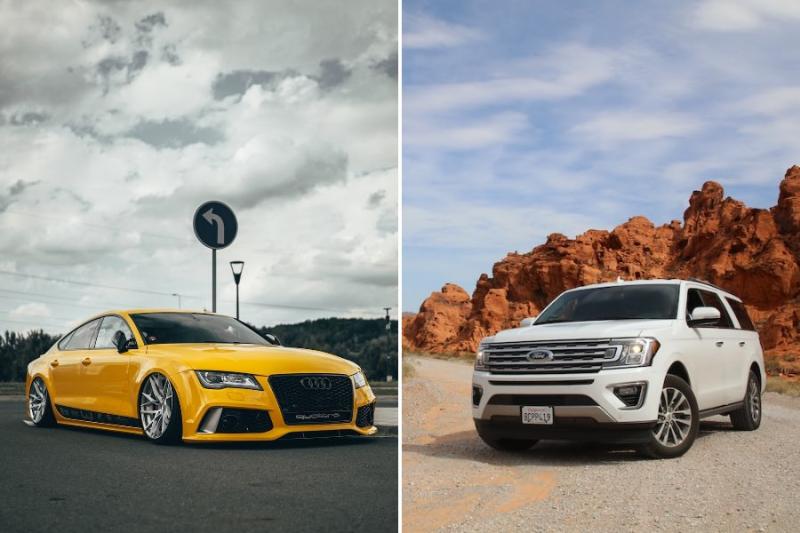The main difference between a car and an SUV (Sport Utility Vehicle) is how big they are, what they are made to do, and how they look. Most cars are smaller and have different body styles, like sedans, hatchbacks, and coupes. They are made for everyday driving and put comfort, manoeuvrability, and petrol mileage first. SUVs, on the other hand, have more extensive, taller bodies that are built on a truck or car-like platform. They have more ground clearance, roomier interiors, and can often go off-road. SUVs usually have more space for cargo, higher seats, and the option for all-wheel or four-wheel drive. This makes them suitable for driving in different conditions and for families.
What is a Car?
A car, also called an automobile, is a motorised vehicle with wheels mostly made to carry people and their belongings. Cars usually have four wheels and can hold up to five or seven people, depending on the model.
Cars come in different body styles, such as sedans, hatchbacks, coupes, convertibles, and station waggons, to meet the needs and want of different people. They are made to be driven every day on paved roads and give the most importance to fuel efficiency, manoeuvrability, comfort, and safety features.
Cars can be powered by engines that burn fuel, electric motors, or hybrid systems that use both. Technology improvements in cars have led to better petrol mileage, less pollution, and the development of advanced driver assistance systems (ADAS), which make driving safer and more convenient.
Cars are used for more than just personal transportation. They are used for commuting, recreation, and business, like taxis or ride-sharing services. Cars have significantly impacted modern society, changing how cities are planned, how the economy grows, and how people move around.
In short, a car is a motorised vehicle with wheels mostly used to get people from one place to another. Many different body styles and features suit different tastes and needs. Cars have become essential to modern life because they make it easier to get around and help the economy grow.
What is an SUV?
SUVs, or Sport Utility Vehicles, are distinguished by their greater size, increased ground clearance, and flexible capabilities. SUVs usually have tall bodies and significant interiors, so they have plenty of room for individuals and possessions. This makes them suitable for families and people who need extra storage space.
SUVs come in many different sizes, from small crossovers to big ones. Many SUVs have options for all-wheel drive or four-wheel drive, which makes them better off-road or in bad weather. This makes them a popular choice for people needing a car that can handle various driving conditions.
SUVs used to be built on truck-like platforms, but more and more modern SUVs are being built like cars, which makes them more comfortable, more accessible to drive, and better on gas. SUVs usually use more gas and put out more pollution than smaller cars. Still, technological advances have led to the creation of hybrid and electric SUVs that use less gas and are better for the environment.
In short, an SUV is a larger, more versatile car with higher ground clearance and often the ability to go off-road. It has a roomy interior for people and things, making it a popular choice for families, outdoor activities, and people who need a car that can handle various driving conditions.
Difference Between Car and SUV
A car and an SUV (Sport Utility Vehicle) are fundamentally different because of their size, body style, ground clearance, driving capabilities, and intended function. These differences have an effect on how they perform, how much gas they consume, how comfortable they are, and how well they fit a wide range of passenger needs and driving scenarios.
Size
The typical car is shorter and lower to the ground, whereas the typical SUV is taller and more comprehensive, allowing for more passenger room and a more elevated driving posture.
Body Style
Sedans, hatchbacks, coupes, and convertibles are examples of car body designs available. SUVs are instantly recognisable thanks to their high ground clearance and boxy, upright silhouette.
Ground Clearance
Cars’ ground clearance is reduced so they can drive more easily on paved roads and in normal conditions. SUVs’ higher ride height makes them more capable off-road and on more challenging terrain.
Driving Capabilities
On paved roads, cars are designed with mobility, fuel economy, and comfort in mind. SUVs with all-wheel or four-wheel drive choices are a huge help off-road or in bad weather.
Intended Use
In addition to being convenient for getting around town, modern cars are also friendly to the environment and offer high levels of comfort for their passengers. SUVs are the best option for families, adventurers, and anyone who regularly face a wide range of road conditions because of their roomy cabins and adaptable features.
To sum up, a car and an SUV fundamentally differ in size, body style, ground clearance, driving skills, and intended use. These characteristics allow them to meet the varying demands of drivers and passengers in terms of speed, petrol mileage, interior luxury, and adaptability to changing road conditions.






